ACUFO-1945-05-17-SOUTHNAGOYA-8
The Tactical Mission report for mission 176 by the 21st Bomber Command of the U.S. Army Air Forces documented the air raid of the night of May 16-17, 1945, over the South Nagoya urban area in Japan. Several cases of “balls of fire” and other oddities observed by the aircrews of the B-29's bombers appear in this report.
In one instance, we are told:
“b. Three possible jet-propelled aircraft were reported. The B-29 reporting them was at 13,000 feet and the 3 possible jets were 5000 feet below and 500 yards behind. These planes were described as being small and having a single, continuous, reddish white flame trailing from underneath their wings. The flame was about 3 feet wide at the base and 15 feet long. There were no spurts of flame seen. One of these planes was seen to go into a 45-degree dive and into the clouds with the flame dying out. The other 2 continued to pursue the B-29 but they appeared unable to gain altitude. These 2 possible jet aircraft were lost in a cloud, and when last seen they were maintaining a straight and level course.”
| Date: | May 17, 1945 |
|---|---|
| Time: | Night. |
| Duration: | ? |
| First known report date: | May 17, 1945 |
| Reporting delay: | Hours. |
| Country: | Japan |
|---|---|
| State/Department: | Aichi |
| City or place: | South Nagoya |
| Number of alleged witnesses: | 1 to 11 |
|---|---|
| Number of known witnesses: | ? |
| Number of named witnesses: | 0 |
| Reporting channel: | Military mission report. |
|---|---|
| Visibility conditions: | Night, undercast. |
| UFO observed: | Yes. |
| UFO arrival observed: | ? |
| UFO departure observed: | ? |
| UFO action: | |
| Witnesses action: | |
| Photographs: | No. |
| Sketch(s) by witness(es): | No. |
| Sketch(es) approved by witness(es): | No. |
| Witness(es) feelings: | ? |
| Witnesses interpretation: | ? |
| Sensors: |
[X] Visual: 1 to 11.
[ ] Airborne radar: [ ] Directional ground radar: [ ] Height finder ground radar: [ ] Photo: [ ] Film/video: [ ] EM Effects: [ ] Failures: [ ] Damages: |
|---|---|
| Hynek: | NL |
| Armed / unarmed: | Armed, 12 Browning M2 12.7 mm machine guns. |
| Reliability 1-3: | 3 |
| Strangeness 1-3: | 2 |
| ACUFO: | Unidentified. |
[Ref. aaf1:] U.S. ARMY AIR FORCES:
This report was of the 21st Bomber Command Tactical Mission No. 176, flown 16-17 May 1945, the target being the Mitsubishi Aircraft Works at the South of the Nagoya Urban Area, Japan.
The units involved were the 58th, 73rd, 313th and 314th Bombardment Wings. The take-off was at Iwo Jima, the initial point (IP) was at Biwa Lake, landfall was at O Shine.
The targets were first reached at 161705Z and last at 161930Z, i.e. in local time, first at 02:05 a.m. on May 17, 1944, and last at 04:30 a.m. on May 17, 1944.
The report below appeared in the “Enemy Air Opposition” part of the report. This part included information about the enemy aircraft encountered during the mission and what these did.
In this “Enemy Air Opposition” part, there was also a section titled “Observations of Unusual Types”, followed by a section “Balls of fire”, in which several observation of what was thought to be other things than planes, rockets, flares and flak, appeared. It included:
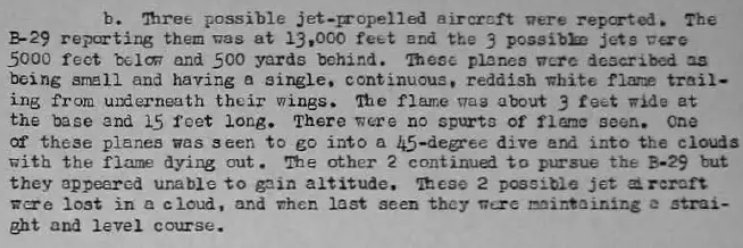
|
[... other cases...]
b. Three possible jet-propelled aircraft were reported. The B-29 reporting them was at 13,000 feet and the 3 possible jets were 5000 feet below and 500 yards behind. These planes were described as being small and having a single, continuous, reddish white flame trailing from underneath their wings. The flame was about 3 feet wide at the base and 15 feet long. There were no spurts of flame seen. One of these planes was seen to go into a 45-degree dive and into the clouds with the flame dying out. The other 2 continued to pursue the B-29 but they appeared unable to gain altitude. These 2 possible jet aircraft were lost in a cloud, and when last seen they were maintaining a straight and level course.
[... other cases...]
Anti-aircraft was described as meager and inaccurate, with large percentage of B-29's reporting no antiaircraft on the target. Searchlights rarely penetrated the undercast, and when they did, “dispensing of rope and desynchronisation of the engines proved effective.”
Out of the 468 U.S. Army aircraft over all targets, none were lost and 20 were damaged.
An estimated number of 30 enemy aircraft were reported, making only 11 attacks on the B-29's. 6 B-29's were damaged by these enemy aircraft but none were destroyed. 5 of the enemy aircraft were reported to carry a searchlight.
7 cases of “balls of fire” reports were included in the report of this mission - the summary said “eight or ten” - in the specific section “Balls of fire” part of the mission reports, with also one case of “possible jets” (Japan had no jet planes) and 2 “possible Baka” (Japanese piloted rocket flying bomb) in the “Observation of unusual types” section. This case file is about 1 of these observations, I documented each case of this mission in its own file.
The Boeing B-29 “Superfortress” was the heaviest bomber of the U.S. Army Air Forces, used in operations from May 8, 1944 and on. Its maximum speed was 574 km/h.
Its defensive armament was 12 Browning M2 12.7 mm machine guns.
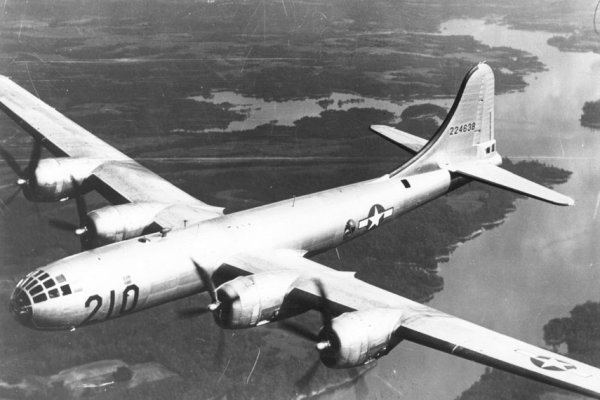
|

|
“Baka”:
The Yokosuka MXY-7 Ohka was a Japanese rocket plane used for suicide “Kamikaze” missions at the end of World War II. It carried an explosive charge of 1,200 kg, constituting a flying bomb, it was dropped from the belly of a twin-engine Mitsubishi G4M “Betty” bomber. Guidance was provided by the pilot alone, the machine flew at 900 km/h and was not very maneuverable, it is known that many “Baka” had exploded in flight before reaching their target. The first use took place on March 16, 1945, the last recorded use took place on June 22, 1945.
In historical sources, all “Baka” attacks were carried out by day and against ships. I haven't found any mention of a nighttime “Baka” attack on bombers.
Below: photo of the drop of a “Baka” by a Japanese bomber, by day:
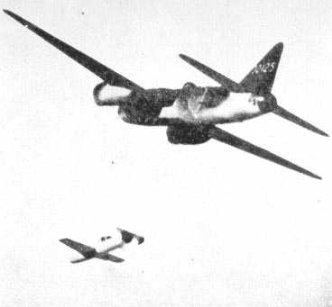
|
With the increase in cases of “balls of fire” during U.S. Army Air Forces missions over Japan in 1944-1945, some analysts had thought that this could be the explanation for the so-called “balls of fire”, or at least, some of them. At the time, this craft was new and little known. Subsequently, historical sources do not mention any flight of “Baka” by night. Some witnesses also explained that the “flame” of the Baka's rocket engine would have varied depending on the viewing angle while the brightness of the “balls of fire” did not change, even when they passed the B-29s. It was also found that the supposed “Baka” never attacked any of the B-29s. In some cases, one can even wonder if Baka reports were not misinterpreted “balls of fire.”
In this case, it makes no sense that the 3 objects were “Bakas”. This would have been a loss of 3 “Bakas” and 3 pilots for no result. No attack occurred.
It was not completely absurd at the time for American military air intelligence to wonder whether these lights were more or less advanced Japanese devices.
The hindsight of time passed allows us to dismiss it. The Kawanishi “Baika” was a project of piloted suicide bomb based on the German V-1 but none were built.
The Nakajima Ki-201 “Karyu” was to be a Japanese copy of the German Messerschmitt Me-262 jet fighter; but at the time of Japan's surrender, not even a prototype had been built.
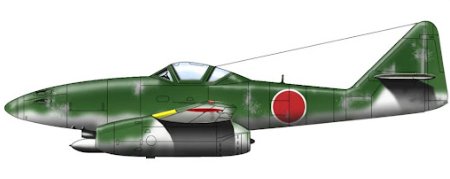
|
Above: Nakajima Ki-201 “Karyu” (sketch).
The Nakajima “Kikka” was also a Japanese copy of the German Messerschmitt Me-262; a prototype was built; but it only made one test flight in Japan, on August 7, 1945.
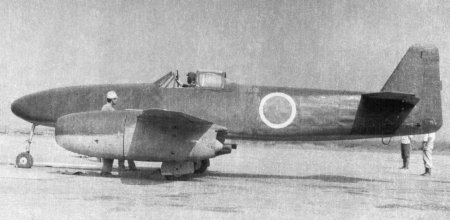
|
Above: Nakajima Kikka.
Mitsubishi J8M “Shusui” and Mitsubishi J8M2 “Shusui-Kai” were prototype rocket-propelled planes licensed from the German Messerschmitt Me-163 “Komet”. But a first test flight only took place on July 7, 1945. It was piloted by test pilot Toyohiko Inuzuka. The launch was successful, but at the altitude of 400 meters, the engine stopped. Inuzuka managed to glide for a while, but the plane hit a building along the landing strip. The J8M was destroyed and Inuzuka died from his injuries the next day. Another of the 5 J8M built exploded on the ground, and the 3 other prototypes never flew and are now in museums: one in the Komaki Plant Museum in Japan, the other at the Planes of Fame Museum in Chino, California, another was at NAS Glenview in the USA in 1946 but was scrapped. There were a few other projects based on the German “Komet”, such as the Rikugun Ki-202, but none were built.

|
Above: Mitsubishi J8M “Susui”.
Were the “3 jets” in the report “conventional” planes? I don't see this as very likely because everything goes against it: the description, the absence of any attack, the inanity of the chase without any attack, the dive into the clouds.
Unidentified.
* = Source is available to me.
? = Source I am told about but could not get so far. Help needed.
| Main author: | Patrick Gross |
|---|---|
| Contributors: | None |
| Reviewers: | None |
| Editor: | Patrick Gross |
| Version: | Create/changed by: | Date: | Description: |
|---|---|---|---|
| 0.1 | Patrick Gross | April 22, 2024 | Creation, [aaf1]. |
| 1.0 | Patrick Gross | April 22, 2024 | First published. |